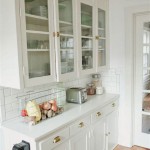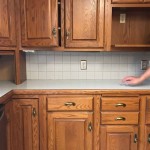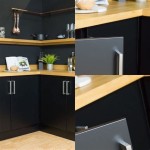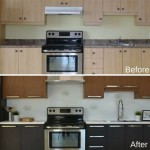Ensure the writing resonates with readers seeking practical advice and information. ## Stained Wood Kitchen Cabinets: A Comprehensive Guide
Stained wood kitchen cabinets remain a popular choice for homeowners seeking to achieve a warm, inviting, and character-rich aesthetic. Unlike painted cabinets that offer a solid, uniform color, stained wood enhances the natural grain patterns and textures inherent in different wood species. This guide provides a comprehensive overview of stained wood kitchen cabinets, exploring various wood types, stain options, design considerations, and maintenance practices.
The selection of stained wood kitchen cabinets involves careful consideration of several factors, including budget, desired aesthetic, durability requirements, and maintenance preferences. Each aspect contributes to the overall success of the kitchen design, ensuring both visual appeal and long-term functionality.
Choosing the Right Wood Species
The foundation of any stained wood cabinet is the wood itself. Different wood species possess unique grain patterns, densities, and natural colors, all of which significantly impact the final appearance of the stained surface. Understanding the characteristics of common wood types enables a more informed decision regarding the desired aesthetic and performance.
Oak: One of the most widely used hardwoods for cabinetry, oak is known for its prominent grain pattern, characterized by pronounced rings and medullary rays. Available in both red and white varieties, oak is durable and readily accepts stain. Red oak has a slightly pinkish undertone, while white oak exhibits a more neutral, tan hue. Oak's open grain necessitates the use of a wood filler prior to staining to achieve a smooth, even finish. The rugged grain also makes oak more difficult to clean compared to smoother wood choices.
Maple: Maple is a closed-grain hardwood characterized by a smoother, more uniform texture than oak. Its subtle grain pattern makes it an excellent choice for contemporary kitchens seeking a clean and understated aesthetic. Maple is generally lighter in color than oak and accepts stain evenly, though blotching can occur if the wood is not properly sealed or conditioned prior to staining. Maple’s hardness also contributes to its durability, resisting dents and scratches that are commonly found with softer wood choices.
Cherry: Renowned for its rich, reddish-brown hue and smooth grain, cherry wood imparts a sense of elegance and sophistication to any kitchen. Cherry darkens naturally over time with exposure to light, developing a deeper, more complex color. This natural aging process should be considered when selecting a stain color, as the final result may evolve over time. Cherry is relatively soft compared to oak and maple, and can be susceptible to dents and scratches, which needs consideration when selecting hardware and kitchen usage habits.
Hickory: Hickory is a dense, strong hardwood with a striking grain pattern characterized by variations in color and texture. Its rustic appeal makes it ideal for country-style or farmhouse kitchens. Hickory can be challenging to stain evenly due to its varying densities, requiring careful preparation and application techniques. The natural variation in color can also result in a less predictable final finish compared to more uniform wood species.
Alder: Often considered a cost-effective alternative to cherry, alder offers a smooth, consistent grain pattern and accepts stain readily. Alder's relatively soft texture makes it easy to work with, but also more prone to dents and scratches. Its lighter color makes it a good base for achieving a wide range of stain colors.
Exploring Stain Options and Application Techniques
The stain color significantly influences the overall look and feel of the kitchen. A wide range of stain colors are available, from light and natural tones to dark and dramatic hues. The selection of a stain color should complement the wood species, the existing décor, and the desired aesthetic. Different staining techniques can also further enhance the final appearance.
Light Stains: Light stains, such as natural, honey, or light oak, accentuate the natural beauty of the wood grain and create a bright, airy atmosphere. These stains are well-suited for smaller kitchens or spaces with limited natural light. Light stains are excellent at enhancing the natural beauty and retaining the light and airy nature in the space. They are typically easier to apply and maintain, as imperfections are less noticeable.
Medium Stains: Medium stains, such as walnut, cherry, or maple, offer a balance between warmth and sophistication. These stains are versatile and complement a wide range of kitchen styles. It adds depth without overpowering the natural wood grain. They work well in most kitchen sizes and styles.
Dark Stains: Dark stains, such as espresso, ebony, or mahogany, create a bold and dramatic look. These stains are best suited for larger kitchens with ample natural light. Dark stains require more careful application to ensure even coverage and prevent blotching. They can make small spaces feel smaller and darker.
Staining Techniques: Various staining techniques can be employed to achieve specific effects. Wiping stains are the most common method, involving applying the stain and then wiping away the excess. Gel stains are thicker and provide more uniform coverage, particularly on woods with uneven grain. Dye stains penetrate deeper into the wood, creating a richer, more vibrant color. Layering stains involves applying multiple coats of different colors to create depth and complexity.
Topcoats: After staining, a protective topcoat is essential to seal the wood and protect it from moisture, scratches, and wear. Polyurethane is a durable and water-resistant topcoat option, available in various sheens, from matte to high gloss. Lacquer provides a smooth, durable finish but requires more specialized application techniques. Varnish offers a traditional look with good durability and water resistance. Choosing the appropriate sheen will significantly impact the final appearance of the cabinets. Matte finishes provide a subtle, natural look, while gloss finishes enhance the richness of the stain color.
Design Considerations and Practicalities
Beyond the choice of wood and stain, several design considerations contribute to the successful implementation of stained wood kitchen cabinets. These include cabinet style, hardware selection, lighting, and overall kitchen layout.
Cabinet Style: The style of the cabinets should complement the overall aesthetic of the kitchen. Traditional kitchens often feature raised-panel doors and ornate detailing, while contemporary kitchens favor flat-panel doors and clean lines. Shaker-style cabinets, characterized by their simple, clean lines and recessed panels, are a versatile choice suitable for both traditional and modern kitchens.
Hardware Selection: The choice of cabinet hardware, including knobs, pulls, and hinges, can significantly impact the overall look and feel of the kitchen. Metal hardware, such as brushed nickel, stainless steel, or oil-rubbed bronze, complements stained wood cabinets well. The style of the hardware should be consistent with the cabinet style and overall kitchen design.
Lighting: Proper lighting is essential to showcase the beauty of stained wood cabinets. Natural light is ideal, but artificial lighting can also be used to enhance the warmth and richness of the wood. Under-cabinet lighting can provide task lighting and highlight the countertop surface. Pendant lights can add decorative interest and provide ambient lighting. The direction and intensity of the light source will drastically change the perceived color and undertones of the stained wood.
Kitchen Layout: The kitchen layout should be carefully considered to maximize functionality and efficiency. The "kitchen work triangle," consisting of the sink, refrigerator, and cooktop, should be optimized for ease of movement. Ample countertop space is essential for food preparation. The placement of cabinets should be strategic to provide adequate storage and minimize clutter.
Maintenance: Proper maintenance is essential to preserve the beauty and longevity of stained wood kitchen cabinets. Regular cleaning with a mild soap and water solution is recommended. Avoid harsh chemicals or abrasive cleaners, which can damage the finish. Dusting with a soft cloth will prevent the buildup of dirt and grime. Periodic polishing with a furniture polish can help maintain the shine and luster of the wood. Addressing spills and stains promptly will prevent permanent damage.
Environmental Considerations: When selecting stained wood kitchen cabinets, it's important to consider environmental factors. Look for cabinets made from sustainably harvested wood, certified by organizations such as the Forest Stewardship Council (FSC). Opt for low-VOC (volatile organic compound) stains and finishes to minimize air pollution. Consider donating or repurposing old cabinets instead of discarding them.
In summary, stained wood kitchen cabinets offer a timeless and versatile design option for homeowners seeking to create a warm, inviting, and character-rich kitchen. By carefully considering the wood species, stain options, design considerations, and maintenance practices, it is possible to achieve a beautiful and functional kitchen that will be enjoyed for years to come.

15 Stunning Kitchens With Stained Cabinets Sincerely Marie Designs Kitchen Rustic Cabinet Design

15 Stunning Kitchens With Stained Cabinets Sincerely Marie Designs

The New Cabinet Stain Colour For Kitchens Trends Wood

15 Stained Wood Kitchen Cabinets To Warm The Heart Of Your Home

The Comeback Of Wood Kitchen Cabinets Farmhousehub

Painted Vs Stained Cabinets Jm Kitchen And Bath Design

15 Stunning Kitchens With Stained Cabinets Sincerely Marie Designs

How To Stain Dark Or Yellow Kitchen Cabinets Lighter

The Comeback Of Wood Kitchen Cabinets Farmhousehub

Wood Cabinets In The Kitchen Making A Comeback Town Country Living
Related Posts








